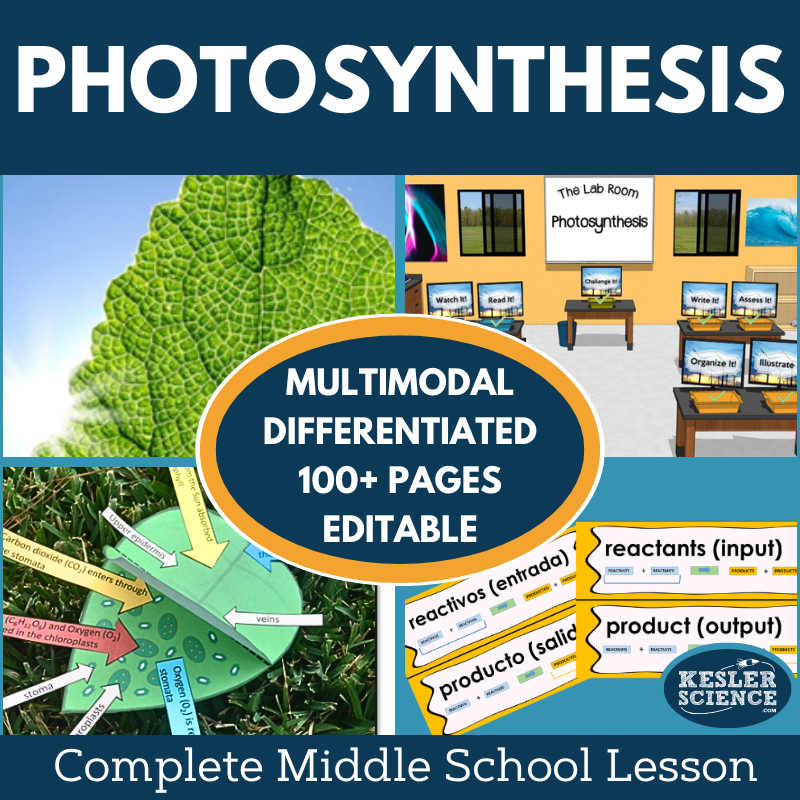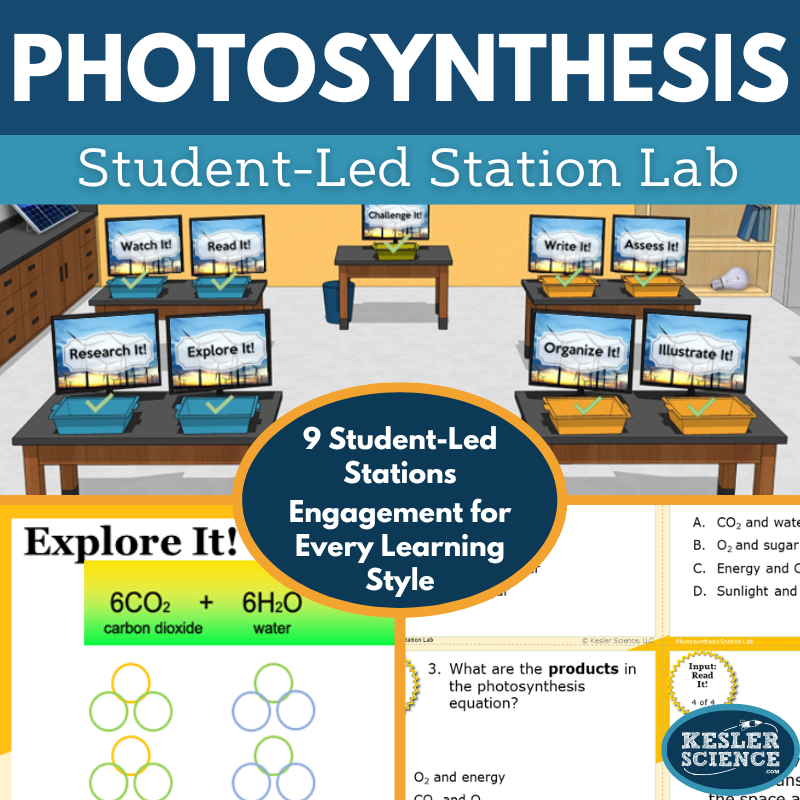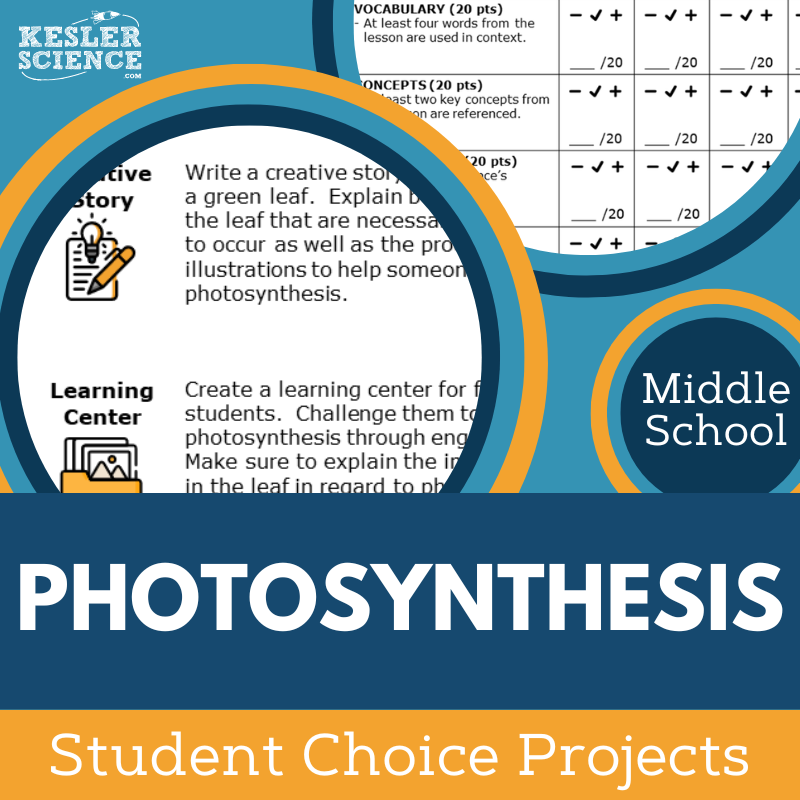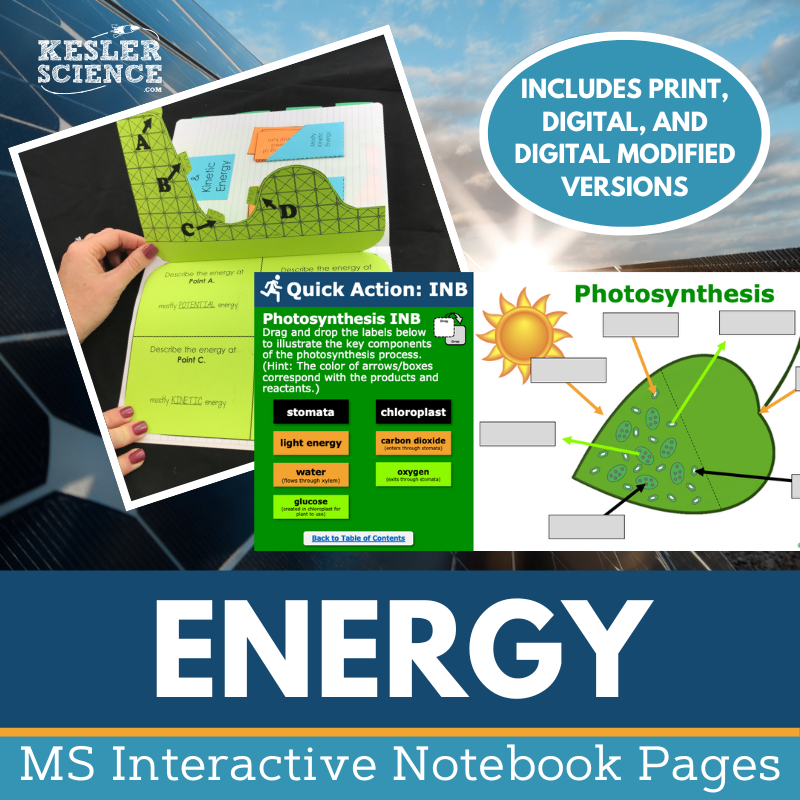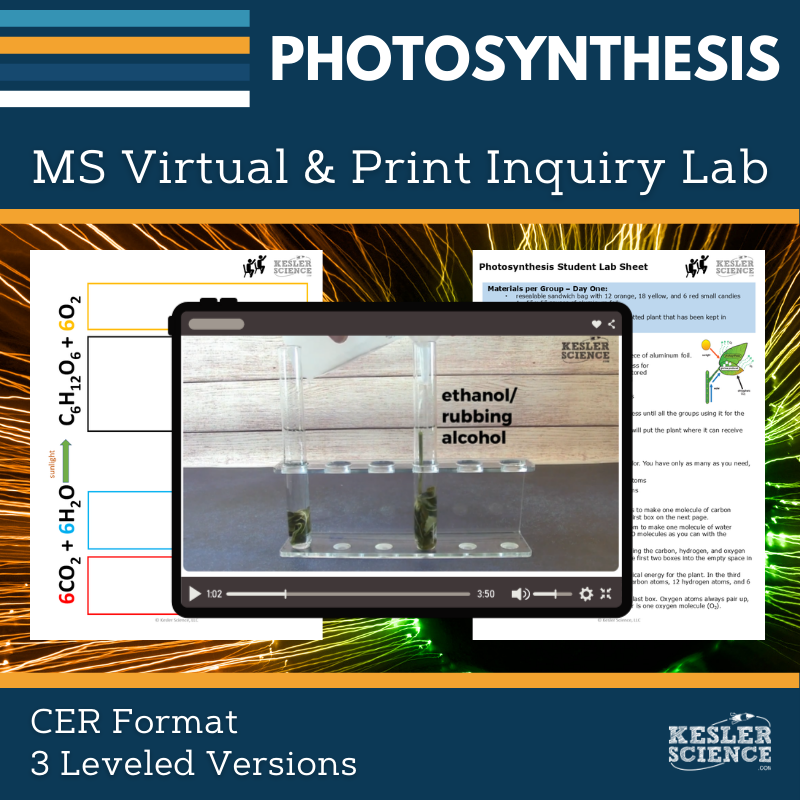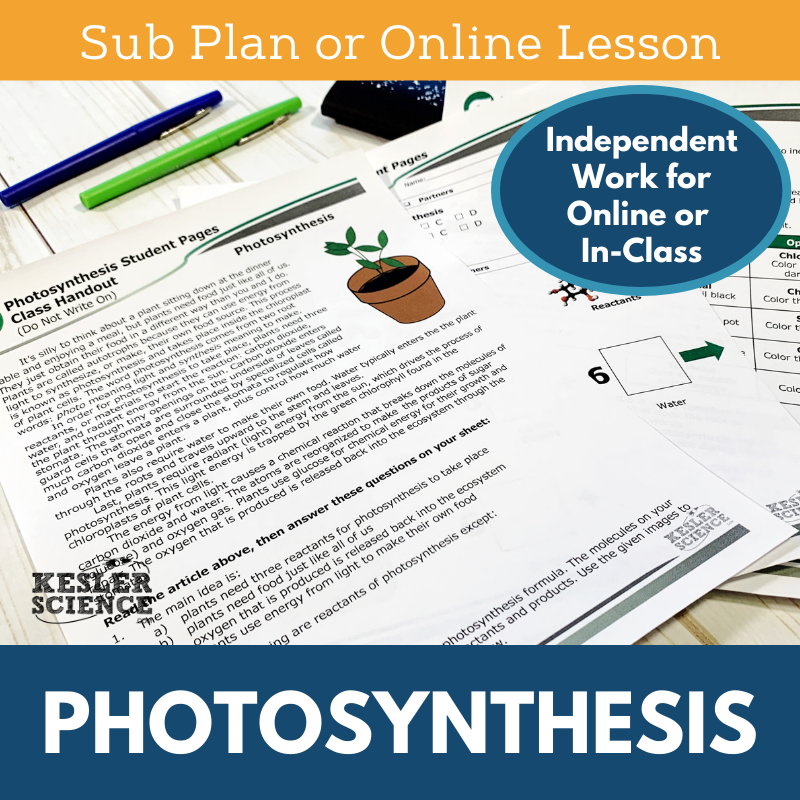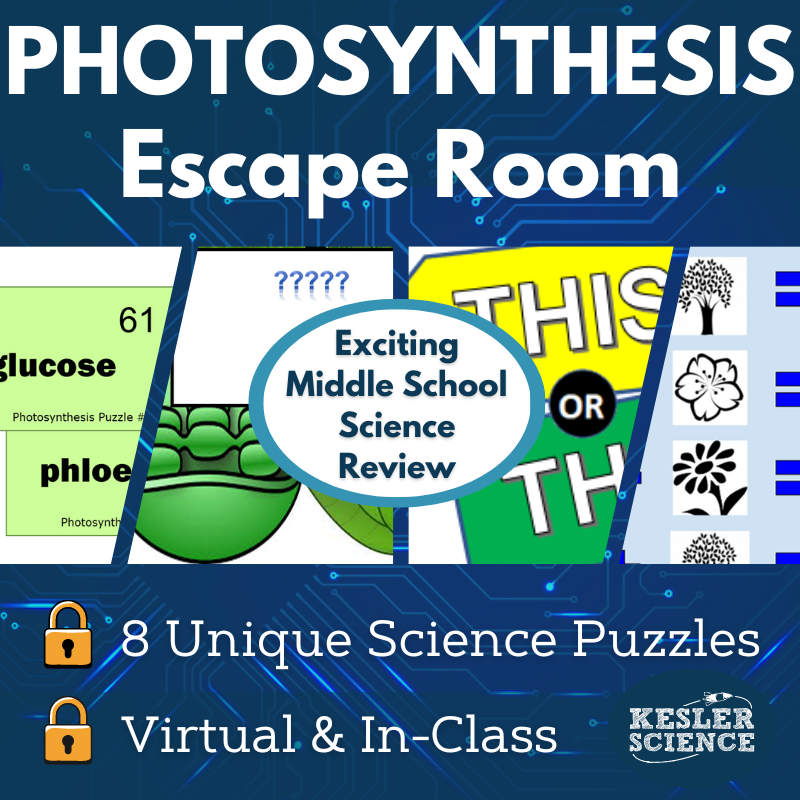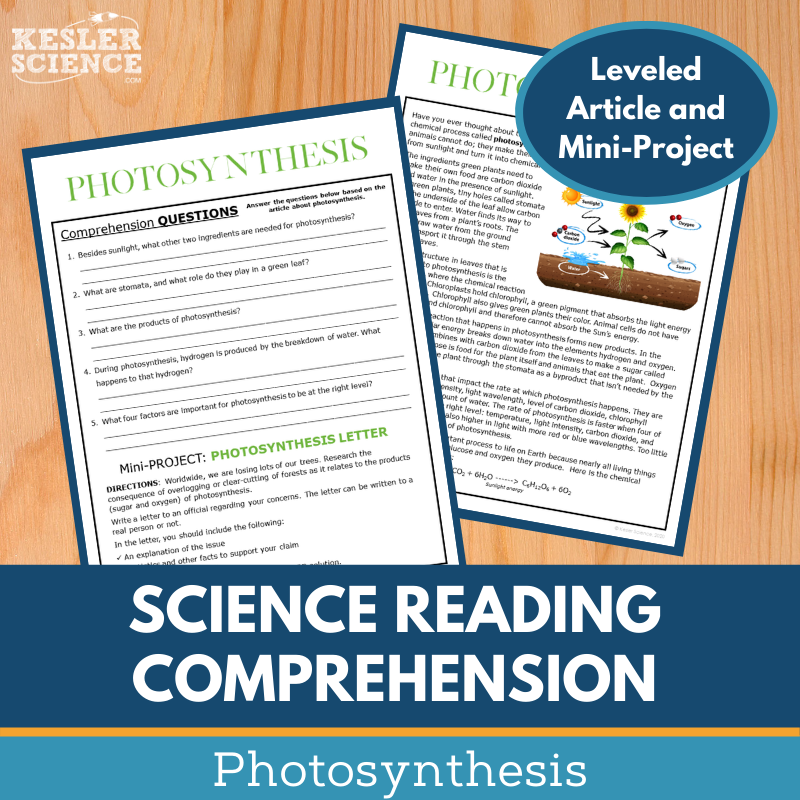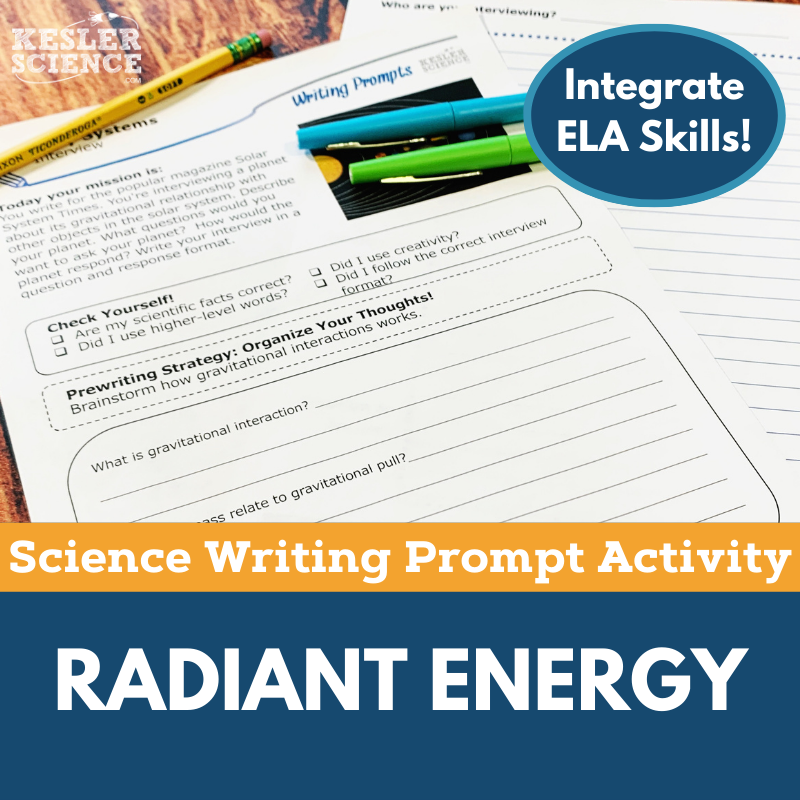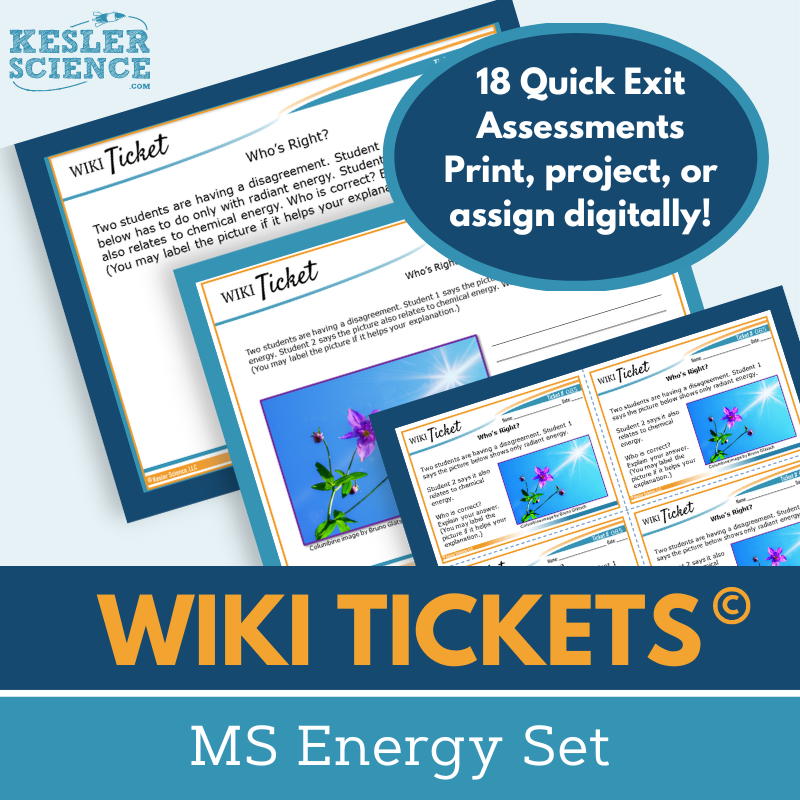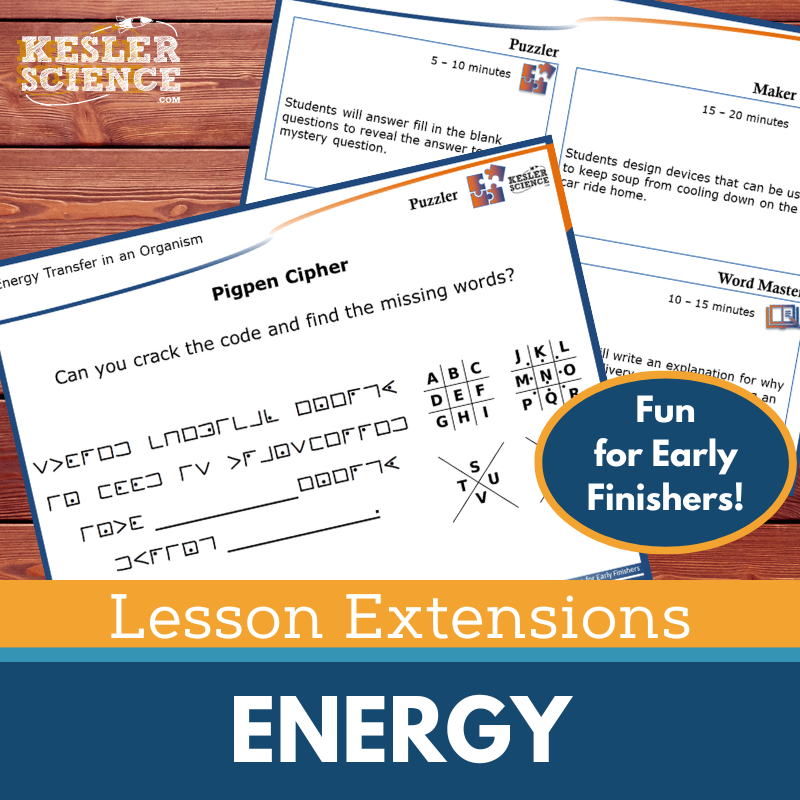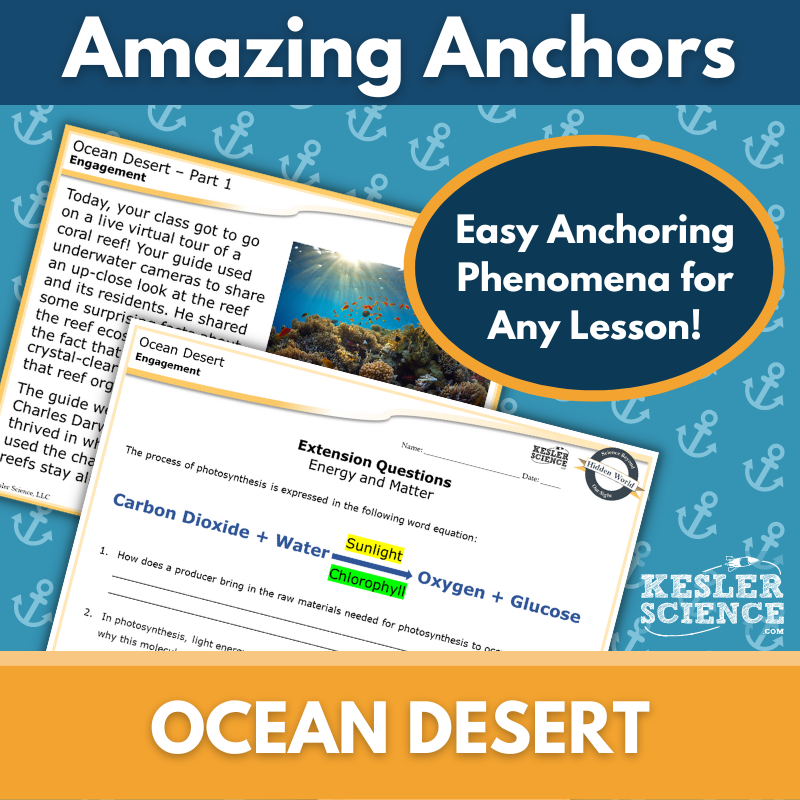Photosynthesis Activities for Middle School Science
The Kesler Science Photosynthesis resources engage middle school students in exploring how radiant energy becomes chemical energy in plants through a student-led, differentiated approach. The resources below will give students a comprehensive understanding of photosynthesis. All of the following materials are also included in the Kesler Science Membership.
The Kesler Science Photosynthesis 5E Lesson is a comprehensive, student-centered unit designed to engage middle school learners in understanding how radiant energy transforms into chemical energy in green plants. The unit includes editable PowerPoints, worksheets, assessments, and student-choice projects. Materials are available in both English and Spanish, and formatted for print or digital use, offering flexibility for classroom or virtual instruction.
Following the 5E Instructional Model, students engage through interactive word walls and discussion prompts before exploring photosynthesis with a differentiated, nine-station lab. These stations incorporate hands-on demos, reading passages, research tasks, videos, card sorts, writing activities, drawing prompts, and assessments. A bonus challenge station offers enrichment opportunities for early finishers.
In the Explanation phase, students work with editable presentations and interactive notebook pages. Learning is extended through student-choice projects, while STAAR 2.0-aligned assessments and review materials provide evaluation opportunities. This lesson is designed for differentiated, student-led learning, allowing teachers to support students while fostering independence and deeper understanding.
The Kesler Science Photosynthesis 5E Lesson is a comprehensive, student-centered unit designed to engage middle school learners in understanding how radiant energy transforms into chemical energy in green plants. The unit includes editable PowerPoints, worksheets, assessments, and student-choice projects. Materials are available in both English and Spanish, and formatted for print or digital use, offering flexibility for classroom or virtual instruction.
Following the 5E Instructional Model, students engage through interactive word walls and discussion prompts before exploring photosynthesis with a differentiated, nine-station lab. These stations incorporate hands-on demos, reading passages, research tasks, videos, card sorts, writing activities, drawing prompts, and assessments. A bonus challenge station offers enrichment opportunities for early finishers.
In the Explanation phase, students work with editable presentations and interactive notebook pages. Learning is extended through student-choice projects, while STAAR 2.0-aligned assessments and review materials provide evaluation opportunities. This lesson is designed for differentiated, student-led learning, allowing teachers to support students while fostering independence and deeper understanding.
This student-led station lab engages middle school learners in exploring how radiant energy from the Sun is transformed into chemical energy through the process of photosynthesis. Designed for classroom or virtual learning, the lab includes all materials and instructions, allowing students to work independently or in small groups. The stations promote active, differentiated learning, with the teacher acting as a facilitator rather than a direct instructor.
Students cycle through nine modular stations that include a mix of hands-on experiments, readings, research, videos, graphic organizers, drawing activities, writing prompts, and assessments. Each station targets a different learning modality to help students understand and apply the concept of photosynthesis. A bonus challenge station offers enrichment opportunities for early finishers through crosswords, games, and mini-projects.
The station lab is part of the broader Photosynthesis 5E Lesson Plan, which includes editable presentations, interactive notebook pages, student projects, and assessments. Materials are provided in both English and Spanish, and all files are compatible with PowerPoint and Google Slides, making this a versatile and effective resource for both in-person and digital instruction.
This student-led station lab engages middle school learners in exploring how radiant energy from the Sun is transformed into chemical energy through the process of photosynthesis. Designed for classroom or virtual learning, the lab includes all materials and instructions, allowing students to work independently or in small groups. The stations promote active, differentiated learning, with the teacher acting as a facilitator rather than a direct instructor.
Students cycle through nine modular stations that include a mix of hands-on experiments, readings, research, videos, graphic organizers, drawing activities, writing prompts, and assessments. Each station targets a different learning modality to help students understand and apply the concept of photosynthesis. A bonus challenge station offers enrichment opportunities for early finishers through crosswords, games, and mini-projects.
The station lab is part of the broader Photosynthesis 5E Lesson Plan, which includes editable presentations, interactive notebook pages, student projects, and assessments. Materials are provided in both English and Spanish, and all files are compatible with PowerPoint and Google Slides, making this a versatile and effective resource for both in-person and digital instruction.
The Photosynthesis Student Choice Projects align with NGSS standards by allowing middle school students to demonstrate their understanding in creative and personalized ways. A project page outlines nine options—including a “design your own” task—with an editable rubric for teacher, peer, or self-assessment. This structure encourages student ownership while supporting varied output styles.
The projects are flexible and differentiated, offering two versions of the project page to meet diverse learning needs. Modified options assist students who need remediation, while advanced learners can be challenged with multiple projects. Teachers can easily adjust the rubric to match specific grading requirements.
Designed for easy classroom implementation, the projects use common materials like paper, markers, and scissors, with many options available for digital completion. The included teacher directions and editable rubrics help streamline planning and assessment.
The Photosynthesis Student Choice Projects align with NGSS standards by allowing middle school students to demonstrate their understanding in creative and personalized ways. A project page outlines nine options—including a “design your own” task—with an editable rubric for teacher, peer, or self-assessment. This structure encourages student ownership while supporting varied output styles.
The projects are flexible and differentiated, offering two versions of the project page to meet diverse learning needs. Modified options assist students who need remediation, while advanced learners can be challenged with multiple projects. Teachers can easily adjust the rubric to match specific grading requirements.
Designed for easy classroom implementation, the projects use common materials like paper, markers, and scissors, with many options available for digital completion. The included teacher directions and editable rubrics help streamline planning and assessment.
The Kesler Science Energy Interactive Notebook Bundle offers an engaging way to teach energy concepts with both print and digital options. It’s perfect for traditional classrooms, 1:1 environments, or distance learning, providing flexibility for teachers and students alike.
Topics include conduction, convection, and radiation, energy transformations, renewable and nonrenewable resources, photosynthesis, potential and kinetic energy, and more. The digital version features a unique interactive notebook PowerPoint, compatibility with Google Slides, reflection pages, teacher answer keys, and a modified version for accommodations. The paper version includes blank templates, pre-filled templates for modified needs, and visual guides for assembly.
This bundle ensures students can actively participate in learning energy concepts while offering teachers versatile tools for instruction and assessment in any learning environment.
The Kesler Science Energy Interactive Notebook Bundle offers an engaging way to teach energy concepts with both print and digital options. It’s perfect for traditional classrooms, 1:1 environments, or distance learning, providing flexibility for teachers and students alike.
Topics include conduction, convection, and radiation, energy transformations, renewable and nonrenewable resources, photosynthesis, potential and kinetic energy, and more. The digital version features a unique interactive notebook PowerPoint, compatibility with Google Slides, reflection pages, teacher answer keys, and a modified version for accommodations. The paper version includes blank templates, pre-filled templates for modified needs, and visual guides for assembly.
This bundle ensures students can actively participate in learning energy concepts while offering teachers versatile tools for instruction and assessment in any learning environment.
The Kesler Science Photosynthesis Inquiry Lab engages students in exploring how plants convert light energy into chemical energy through both hands-on and digital activities. Students begin by partially covering a destarched leaf and placing the plant in sunlight for several hours. On the second day, they test the leaf for photosynthesis products using iodine and model the photosynthesis process with candy. Both print and digital formats include comprehension questions, C.E.R. prompts, and reflection opportunities.
This lab is designed with built-in differentiation, offering three levels: Dependent for on-level learners with guided instructions, Modified for students needing more structure and support, and Independent for advanced learners who take more ownership of their investigation. Each version allows teachers to match the activity to the needs of their students, ensuring accessibility and engagement for all.
The printable version is ideal for in-person learning and includes a full materials list such as ethanol, iodine solution, and a slotted spoon. The digital version requires no physical materials and features an interactive lab file with a recorded demonstration video. Both formats are editable, compatible with Google Slides, and come with teacher resources, answer keys, and editable content for seamless classroom integration.
The Kesler Science Photosynthesis Inquiry Lab engages students in exploring how plants convert light energy into chemical energy through both hands-on and digital activities. Students begin by partially covering a destarched leaf and placing the plant in sunlight for several hours. On the second day, they test the leaf for photosynthesis products using iodine and model the photosynthesis process with candy. Both print and digital formats include comprehension questions, C.E.R. prompts, and reflection opportunities.
This lab is designed with built-in differentiation, offering three levels: Dependent for on-level learners with guided instructions, Modified for students needing more structure and support, and Independent for advanced learners who take more ownership of their investigation. Each version allows teachers to match the activity to the needs of their students, ensuring accessibility and engagement for all.
The printable version is ideal for in-person learning and includes a full materials list such as ethanol, iodine solution, and a slotted spoon. The digital version requires no physical materials and features an interactive lab file with a recorded demonstration video. Both formats are editable, compatible with Google Slides, and come with teacher resources, answer keys, and editable content for seamless classroom integration.
The Kesler Science Photosynthesis Sub Plan provides a complete lesson for students, from a warm-up puzzle to an assessment. Students explore the photosynthesis process by reading a passage, completing an activity using cards to understand the formula, and creating a short skit incorporating key vocabulary like chloroplast, light energy, and glucose. For early finishers, there are extension activities such as analyzing a photosynthesis table or drawing a diagram showing products and reactants.
The sub plan includes clear instructions for substitutes, a letter to the sub, and a student PDF for either in-class or distance learning. The distance learning version also comes with a Google Form answer sheet, making it ideal for remote or at-home assignments. The lesson is designed to minimize downtime and keep students engaged with activities, assessments, and extension tasks.
This resource is flexible and can be used for a variety of purposes, such as for substitutes, ISS students, homework, or small groups. It includes answer keys, editable documents, and behavior checkpoints to ensure smooth and effective learning. Whether in the classroom or virtual, the Photosynthesis Sub Plan makes it easy for teachers to step away while keeping students on track.
The Kesler Science Photosynthesis Sub Plan provides a complete lesson for students, from a warm-up puzzle to an assessment. Students explore the photosynthesis process by reading a passage, completing an activity using cards to understand the formula, and creating a short skit incorporating key vocabulary like chloroplast, light energy, and glucose. For early finishers, there are extension activities such as analyzing a photosynthesis table or drawing a diagram showing products and reactants.
The sub plan includes clear instructions for substitutes, a letter to the sub, and a student PDF for either in-class or distance learning. The distance learning version also comes with a Google Form answer sheet, making it ideal for remote or at-home assignments. The lesson is designed to minimize downtime and keep students engaged with activities, assessments, and extension tasks.
This resource is flexible and can be used for a variety of purposes, such as for substitutes, ISS students, homework, or small groups. It includes answer keys, editable documents, and behavior checkpoints to ensure smooth and effective learning. Whether in the classroom or virtual, the Photosynthesis Sub Plan makes it easy for teachers to step away while keeping students on track.
The Kesler Science Photosynthesis Escape Room offers a dynamic way for students to apply their knowledge of photosynthesis in a fun and immersive setting. Teachers have full control over the eight independent puzzles, allowing them to choose and sequence the challenges based on the class period length. Whether you opt for the simple manila envelope method or a more authentic escape room setup with locks and a storage box, this activity brings excitement to the learning process.
The escape room also includes options for virtual learning. Teachers can assign the Single Student Digital Version PowerPoint for students to solve on platforms like Google Slides or email the printable Single Student Print Version for at-home use. These digital resources are customizable and come with an answer key, a challenge-setting video, and editable templates.
In addition to detailed teacher directions and puzzles, this resource includes a list of prize ideas, reward templates, and 30 unique signs for a fun photo finish. Whether used in-person or virtually, this escape room provides an engaging, hands-on way to assess students’ understanding of photosynthesis.
The Kesler Science Photosynthesis Escape Room offers a dynamic way for students to apply their knowledge of photosynthesis in a fun and immersive setting. Teachers have full control over the eight independent puzzles, allowing them to choose and sequence the challenges based on the class period length. Whether you opt for the simple manila envelope method or a more authentic escape room setup with locks and a storage box, this activity brings excitement to the learning process.
The escape room also includes options for virtual learning. Teachers can assign the Single Student Digital Version PowerPoint for students to solve on platforms like Google Slides or email the printable Single Student Print Version for at-home use. These digital resources are customizable and come with an answer key, a challenge-setting video, and editable templates.
In addition to detailed teacher directions and puzzles, this resource includes a list of prize ideas, reward templates, and 30 unique signs for a fun photo finish. Whether used in-person or virtually, this escape room provides an engaging, hands-on way to assess students’ understanding of photosynthesis.
The Kesler Science Photosynthesis Reading Comprehension activity helps middle school students explore how sunlight is converted into chemical energy through the process of photosynthesis. Students read a nonfiction article on the topic, followed by comprehension questions to deepen their understanding. Additionally, they write a letter addressing deforestation concerns, further encouraging critical thinking and application of the topic.
This resource is designed to improve reading comprehension and science literacy. The article is leveled for middle school students and includes two versions to accommodate varying reading abilities. Engaging, colorful graphics make the content accessible and easy to understand, whether used in print or digitally.
Perfect for in-class or virtual learning, the activity includes tools such as Cornell notes templates and is compatible with platforms like Google Classroom, MS Teams, and Canvas. It's a versatile resource that supports diverse learning needs and promotes meaningful classroom discussions and individual reflection.
The Kesler Science Photosynthesis Reading Comprehension activity helps middle school students explore how sunlight is converted into chemical energy through the process of photosynthesis. Students read a nonfiction article on the topic, followed by comprehension questions to deepen their understanding. Additionally, they write a letter addressing deforestation concerns, further encouraging critical thinking and application of the topic.
This resource is designed to improve reading comprehension and science literacy. The article is leveled for middle school students and includes two versions to accommodate varying reading abilities. Engaging, colorful graphics make the content accessible and easy to understand, whether used in print or digitally.
Perfect for in-class or virtual learning, the activity includes tools such as Cornell notes templates and is compatible with platforms like Google Classroom, MS Teams, and Canvas. It's a versatile resource that supports diverse learning needs and promotes meaningful classroom discussions and individual reflection.
The Radiant Energy science writing activity engages middle school students in exploring physical science concepts through a creative “A Day in the Life” story format. This low-prep resource is designed for print or digital use, allowing students to enrich their science understanding through writing while supporting both in-person and virtual instruction.
Aligned to TEKS and NGSS standards, the activity includes teacher directions, answer guides, rubrics, and differentiated student handouts in both full and half-sheet formats. A digital version is also provided via editable PowerPoint or Google Slides, making it easy to assign across diverse learning environments.
This versatile writing prompt works well as a cross-curricular activity, pre-test assessment, student choice project, or review for early finishers. It’s also ideal for TELPAS samples, extra credit, or make-up work, making it a flexible tool for differentiation and classroom engagement.
The Radiant Energy science writing activity engages middle school students in exploring physical science concepts through a creative “A Day in the Life” story format. This low-prep resource is designed for print or digital use, allowing students to enrich their science understanding through writing while supporting both in-person and virtual instruction.
Aligned to TEKS and NGSS standards, the activity includes teacher directions, answer guides, rubrics, and differentiated student handouts in both full and half-sheet formats. A digital version is also provided via editable PowerPoint or Google Slides, making it easy to assign across diverse learning environments.
This versatile writing prompt works well as a cross-curricular activity, pre-test assessment, student choice project, or review for early finishers. It’s also ideal for TELPAS samples, extra credit, or make-up work, making it a flexible tool for differentiation and classroom engagement.
The Kesler Science Energy WIKI Tickets provide flexible, formative assessments for 6th-8th grade science topics in a fun and engaging format. This set includes 18 assessments, each aligned to NGSS and TEKS standards, covering topics like energy transformations, thermal energy transfer, wave characteristics, and more. WIKI Tickets can be used in various formats, including projection, printable handouts, and interactive digital versions for virtual or in-person learning.
Each topic offers five formats: full-screen projection, full-, half-, and quarter-page handouts, and editable PPT or Google Slides files for digital use. A bonus table of contents aligns each ticket to specific standards, ensuring comprehensive coverage. These assessments are perfect for exit tickets, bellringers, or gauging student understanding throughout a lesson.
"WIKI" stands for "What I Know Is," emphasizing student reflection and learning. Whether used in a traditional classroom or remote setting, these colorful and versatile assessments help you monitor progress effectively while keeping students engaged.
The Kesler Science Energy WIKI Tickets provide flexible, formative assessments for 6th-8th grade science topics in a fun and engaging format. This set includes 18 assessments, each aligned to NGSS and TEKS standards, covering topics like energy transformations, thermal energy transfer, wave characteristics, and more. WIKI Tickets can be used in various formats, including projection, printable handouts, and interactive digital versions for virtual or in-person learning.
Each topic offers five formats: full-screen projection, full-, half-, and quarter-page handouts, and editable PPT or Google Slides files for digital use. A bonus table of contents aligns each ticket to specific standards, ensuring comprehensive coverage. These assessments are perfect for exit tickets, bellringers, or gauging student understanding throughout a lesson.
"WIKI" stands for "What I Know Is," emphasizing student reflection and learning. Whether used in a traditional classroom or remote setting, these colorful and versatile assessments help you monitor progress effectively while keeping students engaged.
The Kesler Science Energy Lesson Extensions provide engaging, student-choice activities designed for early finishers or as a wrap-up to energy lessons. These extensions offer rigorous, fun opportunities for critical thinking and creativity while aligning with NGSS and TEKS energy standards.
Each Lesson Extension includes four activities: Puzzler for problem-solving, Maker Space for hands-on STEAM projects, Tech Connection for digital media integration, and Word Master for creative writing. Resources include teacher directions, answer keys, digital projection versions, and printable handouts.
Topics covered range from kinetic and potential energy to photosynthesis, thermal energy, and more. These versatile activities scaffold learning and engage students in deeper exploration of energy concepts, making them perfect for independent learners and classroom enrichment.
The Kesler Science Energy Lesson Extensions provide engaging, student-choice activities designed for early finishers or as a wrap-up to energy lessons. These extensions offer rigorous, fun opportunities for critical thinking and creativity while aligning with NGSS and TEKS energy standards.
Each Lesson Extension includes four activities: Puzzler for problem-solving, Maker Space for hands-on STEAM projects, Tech Connection for digital media integration, and Word Master for creative writing. Resources include teacher directions, answer keys, digital projection versions, and printable handouts.
Topics covered range from kinetic and potential energy to photosynthesis, thermal energy, and more. These versatile activities scaffold learning and engage students in deeper exploration of energy concepts, making them perfect for independent learners and classroom enrichment.
The Amazing Anchors Phenomenon Lesson introduces and reinforces photosynthesis in organisms through a real-world context. Students begin with an introductory reading focused on ocean organisms, accompanied by comprehension and extension questions. The follow-up explanatory reading breaks down the process of photosynthesis in an accessible way, helping students deepen their understanding of the topic.
This no-prep resource includes teacher directions, answer keys, editable materials, and both print and digital formats. It features projection slides, full- and half-sheet handouts, and versions for different learning needs. A differentiated version includes modified language and sentence starters to support student comprehension.
Designed to supplement a main lesson, these readings are ideal for the Engagement and Elaborate phases of the 5E Model. Whether used in the classroom or virtually, this flexible resource helps connect science content to real-world phenomena and supports student understanding through structured, scaffolded activities.
The Amazing Anchors Phenomenon Lesson introduces and reinforces photosynthesis in organisms through a real-world context. Students begin with an introductory reading focused on ocean organisms, accompanied by comprehension and extension questions. The follow-up explanatory reading breaks down the process of photosynthesis in an accessible way, helping students deepen their understanding of the topic.
This no-prep resource includes teacher directions, answer keys, editable materials, and both print and digital formats. It features projection slides, full- and half-sheet handouts, and versions for different learning needs. A differentiated version includes modified language and sentence starters to support student comprehension.
Designed to supplement a main lesson, these readings are ideal for the Engagement and Elaborate phases of the 5E Model. Whether used in the classroom or virtually, this flexible resource helps connect science content to real-world phenomena and supports student understanding through structured, scaffolded activities.
Year-Round Resources
These year-round activities will increase your students' understanding of many middle school science topics. All of these activities are also included in the Kesler Science Membership.
Visual Data & Graphing
You're not alone if your students struggle with understanding graphs, charts, and tables. It's a skill that takes an enormous amount of practice. This resource will help students build a strong foundation in analyzing data and creating their own data visualizations.
Bell Ringers and Warm-Ups
These middle school science bell ringers are an excellent way to engage your students as soon as they walk into your classroom. This comprehensive FULL YEAR resource includes everything you need to start off each science class with an interesting warm-up activity.
Review Board Games
Each game board has been carefully designed to keep students engaged. There are 10 different action spaces on each board and dozens of question cards. All of the actions are related to science concepts and keep the students motivated throughout the game.
Each game is ready to play. Simply print out the board and the cards and let the students enjoy reviewing nine different units.
Essential Questions
Below are the essential questions associated with the lessons and activities included in this unit. This topic is only one of more than 100 middle school science topics included in the Kesler Science Membership.
-
How does radiant energy from the Sun change into chemical energy through the process of photosynthesis in a green plant?
-
How does the Law of Conservation of Mass relate to photosynthesis?
Kesler Science Membership
Imagine never having to search for another middle school science lesson again. The membership gives you access to ALL of the Kesler Science products in one place (Yes, including everything above).
Say goodbye to long hours of lesson prep.

